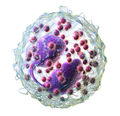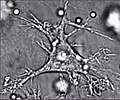This is a list of immune cells, also known as white blood cells, white cells, leukocytes, or leucocytes. They are cells involved in protecting the body against both infectious disease and foreign invaders. [1]
| Image | Name | Subtype | Class | Alternate names | Diameter (μm ) | Main targets | References |
|---|---|---|---|---|---|---|---|
 | Neutrophil | Granulocyte | Neutrophil |
| 12-15 | [2] [3] [4] | |
 | Eosinophil | Granulocyte | Eosinophil |
| 12-15 |
| [2] [3] |
 | Basophil | Granulocyte | Basophil |
| 12-15 |
| [2] [3] [5] |
 | Mast cell | Granulocyte | Mast cell |
| 8-20 |
| [6] [7] |
 | Macrophage | Monocyte | Macrophage | 20-21 |
| [8] [9] | |
 | Histiocyte | Monocyte | Macrophage |
| 20-21 |
| [10] [8] |
 | Kupffer cell | Monocyte | Macrophage |
| 20-21 |
| [11] [8] |
 | Alveolar macrophage | Monocyte | Macrophage |
| 20-21 |
| [8] |
 | Dendritic cell | Monocyte | Dendritic cell |
| 10-15 |
| [12] [13] |
 | B cell | Lymphocyte | B cell |
| 8-10 |
| [14] [4] |
 | Plasma cell | Lymphocyte | B cell |
| 8-10 |
| [4] [15] |
 | Memory B cell | Lymphocyte | B cell |
| 8-10 |
| [4] [16] |
 | Killer T cell | Lymphocyte | T cell |
| 8-10 |
| [4] [17] |
 | Memory T cell | Lymphocyte | T cell |
| 8-10 |
| [4] [18] |
 | T helper cell | Lymphocyte | T cell |
| 8-10 |
| [4] [19] |
 | Natural killer T cell | Lymphocyte | T cell |
| 6-7 |
| [20] [21] |
 | Innate lymphoid cell | Lymphocyte | Innate lymphoid cell |
| ~6 |
| [22] [23] |
 | Natural killer cell | Lymphocyte | Innate lymphoid cell |
| 6-7 |
| [21] [24] |